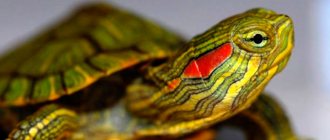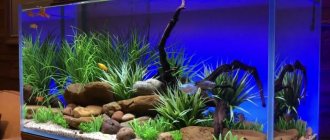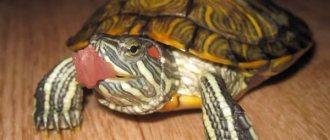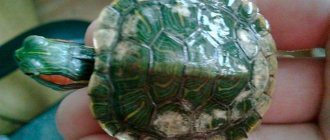There are many reptile lamps sold in pet stores today, but not all of them may be equally beneficial for your pets.
Moreover, the same lamp will demonstrate different efficiency under different conditions. When purchasing individual types, you will simply throw money away without getting the desired result.
So how do you choose the most useful lamp for your turtle and are they really necessary? Let's figure it out.
Features of keeping turtles
Under natural conditions, these creatures bask in the sun, receiving everything they need from their rays.
A sunbeam is a very rich spectrum in its components.
At home, you will have to recreate a similar microclimate for the full development and growth of the reptile. Therefore, at home they are placed in special aquariums or terrariums.
If your pet is a waterfowl, then you will have to make sure that the aquarium contains both water and land at the same time, in the form of a separate island. Moreover, the temperature on the island should not exceed certain degrees. Which ones will be discussed below.
At the same time, keep in mind that to grow a red-eared turtle, it should be a large aquarium, and not a small basin with palm trees and other crap. For normal growth they need a large space with all the conditions.
In general, keeping such pets entails significant costs for:
- aquarium with tray + reinforced cabinet for it
- powerful filter
- lighting and heating
- thermometers
- land or island
- decor
- cleaning accessories
So before buying a miniature and cute turtle in a pet store, be prepared for some significant expenses. And proper lighting is one of them.
Animal feed
Young sliders should consume at least 70% animal food in their daily diet.
Whereas older reptiles can completely switch to a plant-based diet or maintain meat consumption at 10-25%. The turtle can eat raw and boiled (without salt and spices) pieces of lean meat:
- bird,
- rabbit meat,
- horse meat,
- beef.
Another element of the diet is offal:
- heart,
- navels,
- liver.
Smaller mice are also suitable for feeding.
The slider will not be able to digest fatty types of meat such as lamb or pork.
The fish is suitable for low-fat river fish, from which you need to remove the giblets and bones
It is important to soak the fish in hot water for a few minutes before eating to destroy the thiaminase enzyme to prevent the development of vitamin B1 deficiency.
Aquarium fish can be used as food. For example, swordtails, guppies, goldfish.
As a change to the main diet, a raw mixture of squid, green shrimp and octopus is added. It is sometimes acceptable to give the meat of some snails - mariz, coils, pond snails.
You can diversify the menu with the help of insects. You can feed your red-eared turtle:
- crickets,
- bugs,
- bloodworm,
- grasshoppers
- and even caterpillars.
You can add live or dried gammarus, daphnia and coretra - but this is done occasionally.
The Madagascar cockroach is also not the best food for a turtle.
UVB and UVA rays - what are they?
What should it be like? First, remember, you will need to purchase not one, but two types of lamps.
One of them will be an ultraviolet lamp with a UVB and UVA wave spectrum.
When choosing such light bulbs, the percentage of UVB content is important.
For relatively mature turtles (over 7 years old), it should be at least 5% (UVB 100 or 5.0). For small water and all land animals, choose 10% UVB (or UVB 150 - 10.0).
In this case, initially the paw can be raised slightly higher than the recommended value, and after a couple of months, it is gradually lowered, thereby manually adjusting the level of ultraviolet radiation.
For sick or pregnant turtles, UV lamps containing 10-12% UVB (UVB 200) are recommended.
It is the UVB indicator that plays the greatest role. However, UVA rays in such bulbs are usually about 30%.
What exactly are UV A and UV B rays and what role do they play? Type A sun rays are the ones that cause our skin to tan.
However, they do not pass through the layers of the skin and are harmless in moderate quantities. But type B rays penetrate the skin and, if too intense, can cause diseases, including cancer.
Such lamps (UVB) have a wave spectrum in the range of 290-320 nm. Anything below this range is harmful to both humans and animals.
And anything above 320 nm does not in any way help the formation of vitamin D3.
Roughly speaking:
- UVA - warmth
- UVB – vitamins
- UVC - harm
Any reptile that requires calcium gets it from vitamin D3 (cholecalceferol).
And it, in turn, is synthesized precisely when the animal spends a limited time either under natural sunlight (containing rays A and B in its spectrum), or under special lamps, which are original substitutes for such rays.
Why is ultraviolet needed?
An ultraviolet lamp for a turtle is one of the main sources of a healthy and fulfilling life. There is no way to do without it. In their natural environment, these animals receive ultraviolet radiation in sufficient quantities. Finding themselves in atypical conditions, in captivity, turtles experience a lack of sunlight and often get sick. Ultraviolet deficiency is especially difficult for pregnant females and young animals. Adults deprived of ultraviolet light also suffer from osteopenia and have clear signs of vitamin D deficiency.
The UV lamp for turtles perfectly imitates the sun's rays and promotes the absorption of calcium, which reptiles receive along with their food. Lack of ultraviolet radiation and calcium provokes many diseases, which are often fatal.
Is there an alternative to UV lamps?
Remember that no synthetic vitamin D or special food can fully replace this lighting. This primarily applies to land turtles.
Predators (red-eared animals), in natural habitats, receive an analogue of D3 through eaten animals.
Therefore, feeding sometimes saves them.
However, keeping aquatic turtles without UV for a long time is also not recommended. It's like putting you in a closet with one dim light bulb and stuffing you with all kinds of vitamins.
You will live, but you will acquire a bunch of diseases. The same applies to turtles.
Therefore, to the question “is it possible to do without ultraviolet radiation at all,” the answer is simple - no, it’s impossible.
On land turtles you will see the effects within a few weeks. For aquatic reptiles this will take a much longer period, but there will still be negative consequences.
Gradually, the turtle will develop rickets. The shell will become soft and brittle.
This also risks breaking limbs.
Placing an aquarium directly next to a window does not help, and cannot replace UV lamps. The fact is that sunlight passing through glass almost completely loses ultraviolet radiation, and you will not get any effect or benefit from such savings.
How long should it burn?
The duration of ultraviolet radiation largely depends on the age of the individual. For young turtles, the UV lamp is turned on for at least four hours a day.
If the lighting device is installed correctly and illuminates the entire area of the aquarium, then wherever the animal is, it will receive the necessary dose of ultraviolet radiation.
For turtles that have reached 2-3 years of age, it will be enough to receive radiation for a couple of hours. As the turtle ages, it is necessary to increase the power of the lighting device, since susceptibility decreases with age. For an adult to be healthy, it must sit directly under the lamp for at least an hour.
If your work schedule doesn't allow you to turn off the lights after four hours, don't worry. Some veterinarians believe that long-term exposure is even beneficial for reptiles. To improve the health of a sick turtle, you can leave the lamp on throughout the day. But excess ultraviolet radiation is still not absorbed.
Photoperiod is extremely important for the life of pets in captivity. It is best to set a clear schedule for turning the lights on and off. If you need to heat the terrarium at night, it is better to use infrared lamps that do not emit light.
The dangers of ultraviolet light bulbs
Is such ultraviolet radiation dangerous for humans and other animals? In the quantities emitted by UVB lamps, no, it is not dangerous. You won't even tan under these rays.
What to do if such a light bulb breaks?
Well, firstly, there is very little mercury vapor in them. So no one will get fatal poisoning.
Secondly, you will need to carry out basic disinfection measures. Wear gloves to remove fragments and white powder (luminophor). Next, ventilate the room for 1 hour.
It is not recommended to throw used lamps in the trash.
Hand them over to special points.
How to make it yourself
You can save both time and money on finding what you need by making it yourself. This requires minimal knowledge of electrical and physics.
What do you need:
- incandescent lamp;
- box;
- foil;
- power supply, driver and connector from any unnecessary lighting device;
- cord and plug into the socket;
- fasteners;
- screwdriver;
- soldering iron
Necessary for the lamp What to do:
- Glue the foil to the inside of the box. This increases the lighting area.
- Try on and place in the box in the most convenient way.
- Connect the driver, connector and power supply to the lamp.
- Then connect the wires. Don't forget to observe polarity!
- We attach everything to the box.
- We plug it into the network to check.
- We fix the resulting lighting device in the terrarium.
If you have no experience in assembling basic electrical appliances yourself, assembling the lamp yourself is highly not recommended!
This can lead to various unfortunate consequences - from a short circuit to a fire!
Service life - why so short?
The service life of all such UV lamps is limited and ranges from 3 months to 1 year (depending on the brand and manufacturer).
Please pay special attention that after this period, the lamp must be replaced, even if it has not burned out!
During this time, the ultraviolet spectrum of the light fades away and the light bulb turns into a useless backlight, losing all its UVB percentages.
This occurs due to the burnout of the fluorescent composition and the transition of the spectrum to a longer wavelength. Applies to both tubes and compacts.
And as mentioned above, anything above 320 nm no longer has any benefit and does not contribute to the production of vitamin D3.
That is, light bulbs do not become harmful, they become useless. They can be placed in an aquarium with fish or plants.
Also, the service life depends on power surges (tubes are more durable in this regard), the humidity level in the aquarium, heating temperature and other factors. Therefore, be aware that if it says 1 year on the package, this does not mean that the light bulb will work for exactly the time stated by the manufacturer.
What kind of lighting and heating is needed for aquatic red-eared and land reptiles?
When selecting a UV lamp for a terrarium, you should pay special attention to 2 indicators:
- UVB.
This designation indicates the percentage of medium wave ultraviolet light that the lamp can produce. Medium waves are most important for reptiles, as they are the ones that help them absorb potassium in the wild.
- UVA.
The UVA designation indicates the percentage of long-wave ultraviolet light produced by the lamp. These waves are also important for red-eared turtles.
The power and length of the lamp must be selected taking into account the size of the terrarium.
Typically, red-eared turtles are kept in boxes of 4 to 5 liters. Since they are land reptiles, in these terrariums they need the following parameters:
- UVB should be 5-10%. A lower figure of 2% will not be enough. For pregnant individuals, the spectrum can be increased to 12%.
- UVA no less than 30%. As with UBA, lower rates will not be sufficient for the red-eared slider.
If you install a lamp with such indicators, the pet will develop correctly and the risk of developing rickets will be minimized. There are currently several manufacturers on the market that can provide UV lamps for red-eared turtles:
- SERA;
- JBL;
- ExoTerra;
- Hagen;
- Zoomed;
- Sylvania;
- Arcadia;
- GE;
- Interpet;
- Namiba Terra.
Lamp with or without reflector?
When choosing lamps, it also matters which lamp you screw it into. The fact is that such UV lamps do not have any reflector and they scatter light in all directions.
Therefore, the most effective are lamps equipped with reflectors.
They have a shielded surface in the dome that concentrates the rays and directs them in a given direction. Here is a clear example of two different lamps with the same bulbs and the measured UVB level from them.
The efficiency of a model without a reflector is two times less!
Therefore, think carefully before installing UV bulbs in the body of a regular table lamp.
Do you want to lose such a share of useful radiation?
Place and height of installation of UV lamps in the aquarium
Where to place UV lamps in an aquarium? Compact ones should be located above the island, at a height of about 20-25cm from its level (with a power of about 25W).
Power 15W – 15-17cm from the surface.
In this case, there should be no protective glass between the turtle and the light bulb.
Otherwise, it will retain all the useful ultraviolet radiation.
Fluorescent tubes are attached to the lid and shine evenly over the entire aquarium, and not just on the island.
After installing the lamp at the calculated height, be sure to observe the behavior of the turtle for the first time. If she starts to show anxiety (she starts rubbing her eyes frequently, although this hasn’t happened before), then raise the light bulb a little higher!
Heating lamp in a terrarium
The second necessary lamp is a regular or mirror incandescent light bulb with a power of 40 to 60 W.
Since the turtle is a cold-blooded animal, all processes in its body depend on the ambient temperature. The incandescent light bulb creates the necessary warmth, like the summer sun.
It needs to be installed again above the island, and at such a height that the temperature below is 31-32 degrees.
Measure everything with a thermometer, adjusting the height of the suspension from 20 to 30 cm.
The height will depend primarily on the power of the light bulb. The optimal value is selected experimentally for each aquarium.
From the experience of other turtle lovers, we can give approximate calculations:
- 40W – suitable for small terrariums
Creates a temperature of about 29 degrees at the heating point.
- 50W – for aquariums with dimensions 50*35*30
Provides optimal temperature on the island of 30-33 degrees.
- 60W – for large aquariums 60*40*40
Warms up to a maximum of 35-40C.
The location of the suspension and the height can be adjusted with special sockets with wires on detachable plugs.
JBL has these in stock.
Which is better
Divided:
- by power;
- according to the spectrum of rays;
- to size;
- according to form.
They can look like regular incandescent light bulbs or like long fluorescent tubes. In the latter case, the power coincides with its size. For example, a 50 cm long tube has a power of 50 UVB.
It is best to get advice on choosing the right lamp at a pet store.
Sellers will advise the type depending on the type of turtle, the size of the terrarium and other parameters.
Most often, well-known manufacturers are recommended - Repti Glo 5.0 (ideal for red-eared cats), JBL - Solar Reptil Sun or Arcadia - D3 Reptile Lamp.
Repti Glo terrarium lamps
If these options are not commercially available, any others with ray spectra in the region of 5-12% UVB and 30% UVA will do. If these percentages are not indicated on the package, it is better not to make a purchase. Otherwise it may harm the pet. Most of them can be used both for terrariums with land turtles and for aquariums with freshwater ones.
The main conditions for their proper maintenance are lighting and creating the right temperature. During the day you need to heat the turtle’s place of residence to 30-31°C, at night 16-18°C is enough. To create this temperature regime, one or two incandescent lamps with a power of 40-60 W in the corners will be enough (about the final power and quantity, it is better to consult the consultants of the nearest store, they will give more precise advice based on the size of the aquarium and the type of turtle).
From November to March, turtles go into hibernation; at this time, the ideal temperature for this pet is 8-10°C.
In the summer, it is useful to take the terrarium with the turtle out into the open sun to absorb natural ultraviolet rays and vitamin D3.
Glow time
How long should both reptile lamps be on? Both regular and UV should burn throughout the daylight hours from 10 to 12 hours. At night they are turned off.
To automate this process, it is advisable to purchase a timer socket or time relay.
You manually set the lighting start time (8.00 am) and shutdown time (20.00 pm) on them. Automation will do the rest for you.
In the morning you will be able to sleep longer, and in the evening you will not be distracted from watching your favorite TV series.
Light quality
The main characteristics of a lamp are its intensity and quality of light. The latter is determined by color temperature, measured in degrees on the Kelvin scale and determining the color of visible light. Concepts such as “cold” and “warm” light are also important. Quality is determined by the color rendering index and wave intensity distribution.
Since light is vital for terrarium animals, attention should be paid to its quantitative characteristics. Its high intensity is important so that the length of daylight hours corresponds to the photoperiod of the animal in its natural habitat. The light from the lamp should simulate the new circadian period (cyclical fluctuations in the intensity of biological processes) of the turtle, changing throughout the year.
Three aspects of radiation are important for keeping reptiles:
- ultraviolet;
- visible light (radiation in the visible part of the spectrum);
- infrared (thermal).
All described relationships between the quantitative and qualitative characteristics of light must be taken into account when choosing an ultraviolet lamp for a turtle. It is created with their own hands by a considerable number of exotic animal lovers. This is not difficult if you correctly understand the role of ultraviolet radiation, its sources in the life of reptiles, and also take into account all the necessary parameters.
Dangerous lamps for turtles
Now let's touch on the issue of lamps, which under no circumstances should be installed in an aquarium for turtles.
The following species are a dangerous source of light for them and contribute to the development of all kinds of diseases.
- UV lamps for drying gel polishes or lamps for manicure
- infrared medical heating lamp
- black UV lamp
- UV models for checking banknotes
- lamps from medical UV lamps
- lamps for plants
From these lamps, your turtle will receive radiation, which will lead to burns of the corneas of the eyes and blindness.
Therefore, be careful and install only lamps specifically designed for reptiles.
Short description
Let's get to know the red-eared slider in a little more detail. The turtle got its “name” thanks to the bright red spots near the eyes on its head. Sometimes they can have an orange tint. Mostly turtles are small in size - from 3 to 10 centimeters, although they can also be quite large, giants for their species, reaching a diameter of up to 60 centimeters. The carapace is darker below, has an oval shape and is edged with yellow stripes.
The dorsal part is greenish, and as the turtle matures, it acquires an olive tint or yellowish-brown.
In the first few years of their life, turtles grow very actively; the diameter of the shell can grow up to 10 centimeters in a year. Then they grow much more slowly, adding only up to 2 centimeters every year.
UV+heat combination bulbs
In addition to the UV and incandescent lamps discussed, there are also combination lamps that simultaneously heat and produce ultraviolet light. The so-called UV + heating.
They cost significantly more. However, among them, most of the models, which, while emitting good heat, do not emit so much ultraviolet radiation. With separate lighting you can get much more of it.
At the same time, if a light bulb in separate lighting fails, you will need to replace one thing - an ultraviolet light or an incandescent lamp. In the combined version, you risk being left without light altogether.
The best option is to use UV lamps T8, T5 in the lid of the aquarium and ordinary lamps above the island. The tubes will provide uniform ultraviolet illumination over the entire area, and the regular tubes will comfortably warm up the turtle’s shell.
The decision must be balanced
Before you get a pet turtle, there are a few important things you need to seriously consider:
- Is it possible to care for a pet for a long time, because, as we know, reptiles can live quite a long time.
- Is it possible to purchase the necessary equipment for arranging a comfortable place for a turtle to live in a human home: an aquarium, an incandescent and UV lamp, and also, if the species is aquatic, then filters and purifiers.
- Provide your pet with adequate nutrition. For red-eared fish, this is boiled meat, shrimp, dried gammarus, and for land species - fresh greens all year round.











